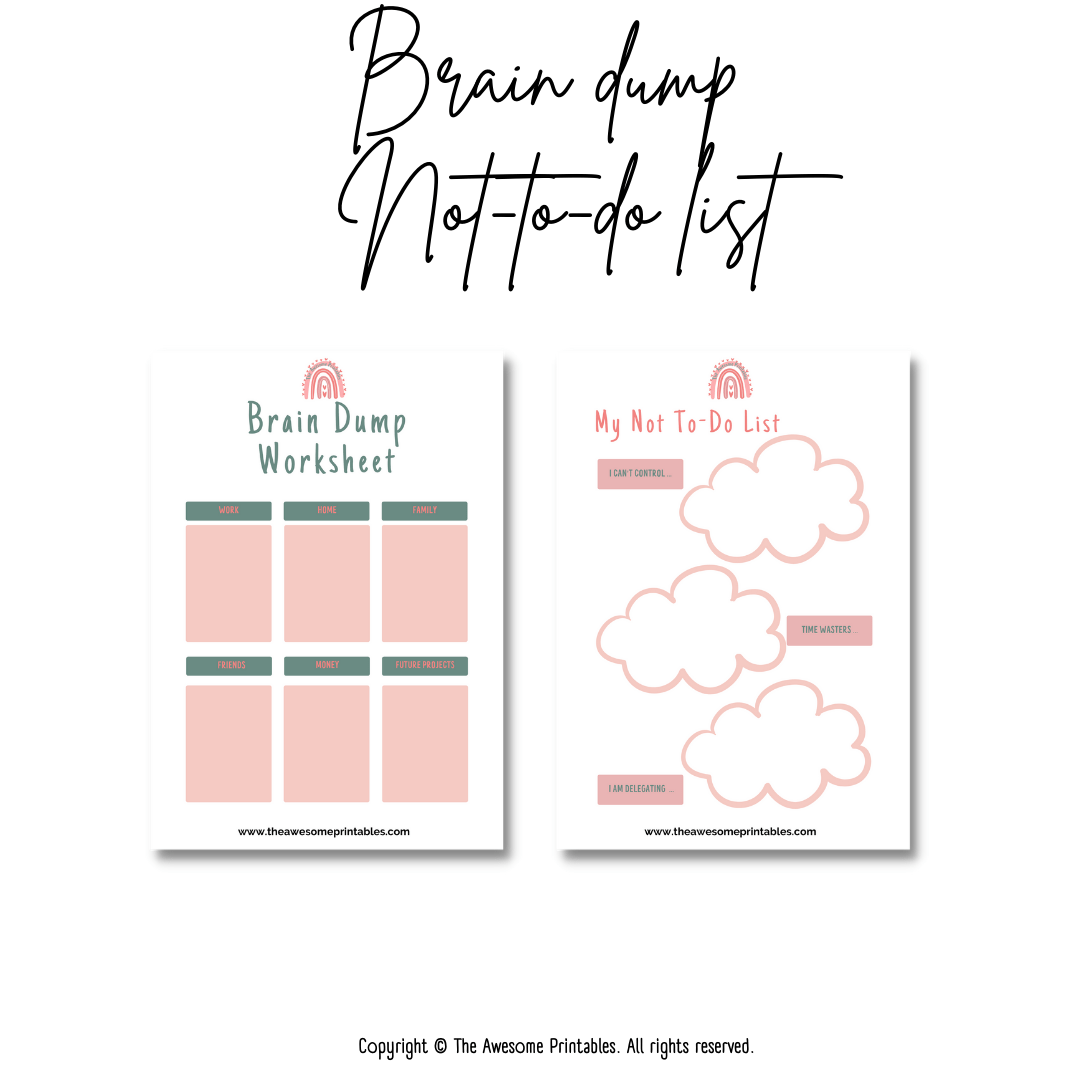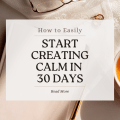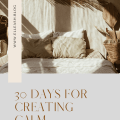This post is all about the simple ways to stay calm in chaos.
This post may contain affiliate links, which means that I earn a small commission with every purchase you make through my links, and of course, at no additional cost to you. I do greatly appreciate it, as it helps me run my blog and post content that will help you in your daily life.
Please read the full disclosure here.
Oh, and just in case — I am NOT a mental health professional! What I write are my experiences, tips & personal advice. If you are in need of help, please don't hesitate to contact a professional!
Please read the full disclosure here concerning that point.
Okay, that's out of the way - READ ON!!
This post is the next one in our 30-day self care challenge on the topic of Creating Calm. In this post, I will be looking at ways in which you can stay calm in chaos and it makes your life unbearably difficult. Enjoy the read!
THIS IS AN ADVERTISEMENT
CONTINUE READING BELOW
How To Stay Calm in Chaos
Hey hey my lovely entrepreneurs,
Life has its ups and downs. There are periods that will be more hectic and crazy than others. During these times, it can really help you to learn some coping strategies. There are some simple ways to stay calm in chaos. Having a settled mind and looking at things from a less frazzled state can truly help you to make clear-headed decisions. Keep these in mind next time life gets turned upside down.
Breathing for calming down
It may sound too good to be true, but this strategy really works. Just count slowly from one to ten. Try to breathe deeply as you do, as this will enhance the effects. This little trick can help you to quickly gain control of your emotions and feel calm in chaos.
And yep, shutting your eyes for a moment blocks out a great deal of the stimuli that are currently vying for your attention. This brief period of visual stillness will allow you to gather your thoughts and to calm yourself.
While a part of meditation is getting in touch with your awareness, another part has to do with relaxing and clearing your mind. Breathing is an important tool to get to both those places. Breathing may seem as simple as breathing in and out; however, this is not entirely the case.
Learning to breathe deeply can help you achieve that calm space you need to relax and destress. Here are a few awesome breathing exercises that I thoroughly enjoy practising when I'm up s*** creek without a paddle, and that I know can work for you as well.

Proper Sitting for Proper Breathing
First and foremost, make sure that you are comfortable. Sitting upright with a straight spine will help the energy flow and prepare you for proper breathing exercises. Do not sit too rigidly, or you will be uncomfortable and unresponsive to the proper breathing format.
Relaxation of the Body
Once you have gotten into a comfortable seated position, it is important to relax your body to prepare it for breathing techniques and meditation. No matter how well you practice your breathing, if your body is tense, you will not have success. Begin by relaxing the muscles in your toes, moving to your ankles, and work your way all the way up to the top of your head. Once your body is in its relaxed position, then it will be time to begin your proper breathing techniques.
Pay attention to your breaths
In the beginning, simply pay attention to your breaths. Be attuned to the rhythm of the breaths, focusing on the in and out of those breaths. Do not try to control those breaths; just be aware of them. It is very important to be aware of how you are breathing in the beginning before trying to learn any new technique on how to breathe. Being aware is an important part of the process.
Pay attention to your body
Once you are acutely aware of how you breathe, it is important to pay attention to your body. If you are not experiencing your stomach rising and falling with each breath, you may be tense in the moment. It is important to have your breath enter into the nostrils and leave through mouth naturally.
establish a rhythm
It is very important to establish a breathing rhythm. Once you become aware of your breathing, you will notice that it is easier to establish a rhythm. Once that rhythm is established, you will find your meditation to flow easily and you will get the most benefit out of that meditation.
THIS IS AN ADVERTISEMENT
CONTINUE READING BELOW
These awesome quotes that I have for you today are all about your breathing and how being intentional with your breathing can really help in creating calm when your household or life is running wild!
Check them out by clicking here, or on the image below. It will take you to the page where you'll be able to download over 15 quotes about breathwork. They come in different sizes to choose from. All you have to do is download them and print out the ones you want.
I have framed some and I love changing them whenever I want some new colors!
Move your body
Exercise is a fantastic way to get your blood flowing and your heartbeat racing. You'll also amp up the productions of endorphins in your body, providing you with extra energy to attack your issues. You don't have to do a full-blown exercise to benefit, though. Taking a leisurely stroll might actually be best during times when you need to chill out. This relaxing activity gets you moving, literally. It can remove you from a stressful environment and give you fresh perspective.
Being out in the fresh air, has so many positive aspects for your well being! Since COVID hit us full-force, we have clearly understood the importance of being out in the open and taking in as much fresh air as possible. Here are few ways in which nature helps you find calm.

Nature Restores the Balance to your Well-Being
There is a significant body of research that supports the claims that nature helps improve psychological health, including depression and anxiety, by calming worries and reducing stress. This allows you to feel more balanced and in control of your life, which helps you focus on what is essential in your life. Spending time in green spaces is associated with finding meaning in life, having more vitality and energy, and having an overall positive outlook.
Those who spend time outside regularly also notice that they can focus their attention and may even have better problem-solving skills or higher levels of creativity. IF you are stuck on a problem or trying to generate new ideas, go outside for a bit and notice how much better your mind is functioning. Nature therapy is even being incorporated into treatments for disorders such as ADHD because it helps to increase attention span.
Nature Can Heal Your Mind and Body
When you are outdoors surrounded by nature or even when you are just looking at nature scenes, your body responds with feeling less stressful, angry, or fearful and feeling more positive. By lowing your blood pressure, reducing your heart rate, relaxing tense muscles, and producing fewer stress hormones, your body’s response to being in nature is clear and resounding.
There are even some studies to suggest that those who spend more time outside are more likely to live longer. Adding natural elements, like plants, to indoor spaces, is one way to bring nature closer to your daily life and improve your overall well-being, if you live in an apartment, or it's harder for you to get out.
Spending time outdoors is not only fun but also good for you. The healing, soothing, and connecting effects of spending time in nature offer lasting benefits to your long-term wellness.
THIS IS AN ADVERTISEMENT
CONTINUE READING BELOW
Try Progressive Muscle Relaxation
An effective strategy for releasing stress from your body without having to exercise, or even move out of your chair, is progressive muscle relaxation. This practice involves tensing and releasing the stress from every muscle group in your body. You can start with your head and work your way downward. Tense up the muscles in your face, hold for a few seconds and then release. This exercise can be completed in just a few minutes, and you'll feel tons better when it's over.
As mentioned in the point above, being out in nature can have a healing effect on your overall wellbeing. It goes without saying that nature can ease pain and discomfort.
In addition to promoting overall better health, nature and being in green spaces can help you cope with pain and chronic conditions. Our brains are genetically programmed to respond positively to water, plants, trees, and animals in a positive way, and you likely find that you are very engrossed in what is around you when you are surrounded by nature. This effect distracts you from pain and other symptoms, which can make you feel more positive about your condition.
When you are sick or immobile, being able to look at natural scenes, such as trees, can be enough to promote better outcomes, according to some researchers. And being outside in the fresh air and sunshine is always going to improve your outlook.
listen to some music

A soothing tune can be relaxing. Up tempo beats add energy when you need a boost. Perhaps something with meaningful lyrics might improve your mood. Whatever you choose, music can have a profound effect on your feelings and is a good option to rely on when you want to calm down or feel better.
how a brain dump can reduce stress
If you have been reading my posts and following me blog and social media posts, you will know that I live with anxiety and that sometimes it can be so overwhelming that I need to take a mini-break from whatever it is that I'm doing, in order to not be completely stressed and overwhelmed by it all!
If you know exactly what I'm talking about, then you know that finding calm can be next to impossible when you have a million thoughts swirling around in your head. It's stressful when you have so many details going on inside your brain. These rambling, disorganized thoughts are always with you and it can seem like there's no escape.
I know of one simple trick that can help you to overcome that helpless feeling. I'd like to share it with you today. It's called a brain dump, and it truly is as easy as it sounds. Once you learn this technique, you'll no longer be forced to deal with the overwhelm of an overcrowded mind. It may still happen, but at least you will know exactly what to do when the old heart rate increases and you can feel your heart beat in your ears!!
what is a brain dump?
I briefly talk introduce it in this post, but here is more thorough information about how a brain dump can reduce stress.
A brain dump is simply taking what's in your brain and transferring it to another place. This place can be onto a piece of paper or into digital form like a computer app or word processing program. What's important is that you clear your mind of all the clutter so that you can think clearly again.
Dumping the excess thoughts and information from your brain to a different storage medium frees up valuable space. It also unloads a heavy burden. You'll feel a lot freer once you've experienced this process.
Think of it like you would transfer data from your computer to an external HDD - this is the same! You are essentially transferring all those crazy & stressful thoughts from your brain into a notebook, your tablet or paper.
The objective of this is so that you are not over stuffing your brain with thoughts that can easily be dealt with later, when you are feeling up to it or are more emotionally equipped to treating that information.
What are the benefits of a brain dump?
There are a number of benefits to performing a brain dump. Let's look at just a few.
First of all, it clears your head. Just seeing the information in front of you gives you a sense of control over it. Your brain is cleared, kind of like a computer cache. There's now more room in it so that it will function better.
Once you have taken all those thoughts from your head and placed them in a place where you can see them, you then have a lot of options.
Information is far easier to sort when it's right in front of you than when it's swirling around in your mind. You can then organize that information into a format that makes sense, helping you to process things and to make plans.
You'll find the information is now organized and more readily managed. It will be easier to gain focus and to be more productive in your work flow.
THIS IS AN ADVERTISEMENT
CONTINUE READING BELOW
how to do a brain dump?
Performing a brain dump is easy.
Choose your format.
If you prefer pen and paper, that's great. Writing things down can be therapeutic, and it can help you to retain information.
However, electronic form also offers benefits to those who prefer to keep digital records. What's important is that you remove the clutter from your mind, and then find a way to organize and process it all.
Set aside some quiet time, at least a half hour. Write down everything that's in your head. Keep going until you can't think of anything else. Try to use the time you've allotted, but don't frustrate yourself if you truly can't think of more.
Then come back to the information later to categorize and organize it in a way that makes more sense.
I have created 2 printables, that you'll be able to download for free, at the end of the post. The BRAIN DUMP printable has been clearly separated into themes, so that you can easily focus your mind on sorting out the information per theme. Because there is no point in getting rid of the info from your head onto paper/tablet, and then stressing over the fact that nothing is ordered and too hard to process!
printableS of the day
in collaboration with theawesomeprintables.com
the takeaway
These are just a handful of ways to stay calm when you're stressed out. Choose the ones that resonate with you, and give them a try the next time you feel overwhelmed or when life is chaotic.
A brain dump is good to do on a weekly basis. You can do it more or less frequently, depending on need. You'll find you feel more refreshed and can think more clearly after your brain dump session.
Until our next post, stay humble, grateful and remember that today may not be the best day, but you can always improve on it!
Elle Ash xo
THIS IS AN ADVERTISEMENT
CONTINUE READING BELOW









